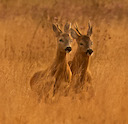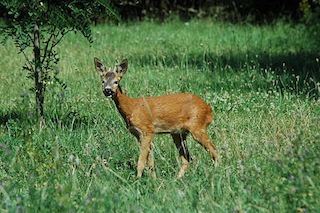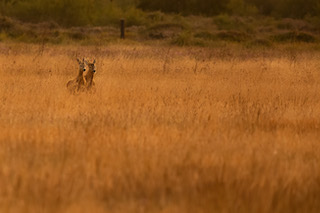 Although more common in the east and centre of Cornwall, Roe Deer have more recently been spreading to the west, including the Lizard. Windmill Farm is a good place to see them.
Although more common in the east and centre of Cornwall, Roe Deer have more recently been spreading to the west, including the Lizard. Windmill Farm is a good place to see them.
Photo: © Richard Birchett
Scientific name: Capreolus capreolus
Other common names: European Roe Deer, Western Roe Deer
Cornish name: Yorgh
What to look for:
- Appearance and colouring: Sandy brown coat which is a more greyish brown in winter. Heart-shaped white rump in female and kidney-shaped rump in males becomes far less obvious in winter. The tail is small and white. Males have short antlers, covered in velvet in early spring, and which are shed in the winter. Young kids have some white and black markings.
- Size: Similar to a goat; length 95 to 135 cm, height at shoulder 65 to 75 cm.
- Where: Open woodland; sometimes fields/grassland.
 The Roe Deer is native to Britain, and has always been present in Scotland. It went extinct in the rest of the Britain in the 1700s, but is now doing well following a reintroduction programme in the nineteenth century. The rutting season is July to August, when the males display some very aggressive territorial fighting. The females do not give birth until the following year, when they produce between one and three kids (often twins) in May to June. The Roe Deer is in fact the only hoofed mammal that displays ‘delayed implantation’ as a breeding strategy: mating takes place in high summer, but the egg does not start to develop until mid-winter. The kids are left on their own in the undergrowth during the day for the first few weeks of life, and then travel alongside their mother until they disperse.
The Roe Deer is native to Britain, and has always been present in Scotland. It went extinct in the rest of the Britain in the 1700s, but is now doing well following a reintroduction programme in the nineteenth century. The rutting season is July to August, when the males display some very aggressive territorial fighting. The females do not give birth until the following year, when they produce between one and three kids (often twins) in May to June. The Roe Deer is in fact the only hoofed mammal that displays ‘delayed implantation’ as a breeding strategy: mating takes place in high summer, but the egg does not start to develop until mid-winter. The kids are left on their own in the undergrowth during the day for the first few weeks of life, and then travel alongside their mother until they disperse.
 Roe Deer are most often spotted in small groups or singly, but in winter may form bigger groups to feed together. They eat leaves, weeds, fungi and ferns among other things, and will stray into arable fields or private gardens.
Roe Deer are most often spotted in small groups or singly, but in winter may form bigger groups to feed together. They eat leaves, weeds, fungi and ferns among other things, and will stray into arable fields or private gardens.
Did you know…?
…The Latin name capreolus means ‘little goat’.
…The original Bambi, from the book by Felix Salten and immortalised on celluloid by Walt Disney, was a Roe Deer.
More information and references:
Cornwall Mammal Group, 2013. The Mammals of Cornwall and the Isles of Scilly (edited by David Groves). Environmental Records Centre for Cornwall and the Isles of Scilly (ERCCIS), Cornwall.
Published: December 2014
Author: Amanda Scott
Photos: Upper, Pascal Vuylsteker, CC BY-SA 2.0; lower (of Roe Deer bucks at Windmill Farm), © Richard Birchett (website and YouTube)
